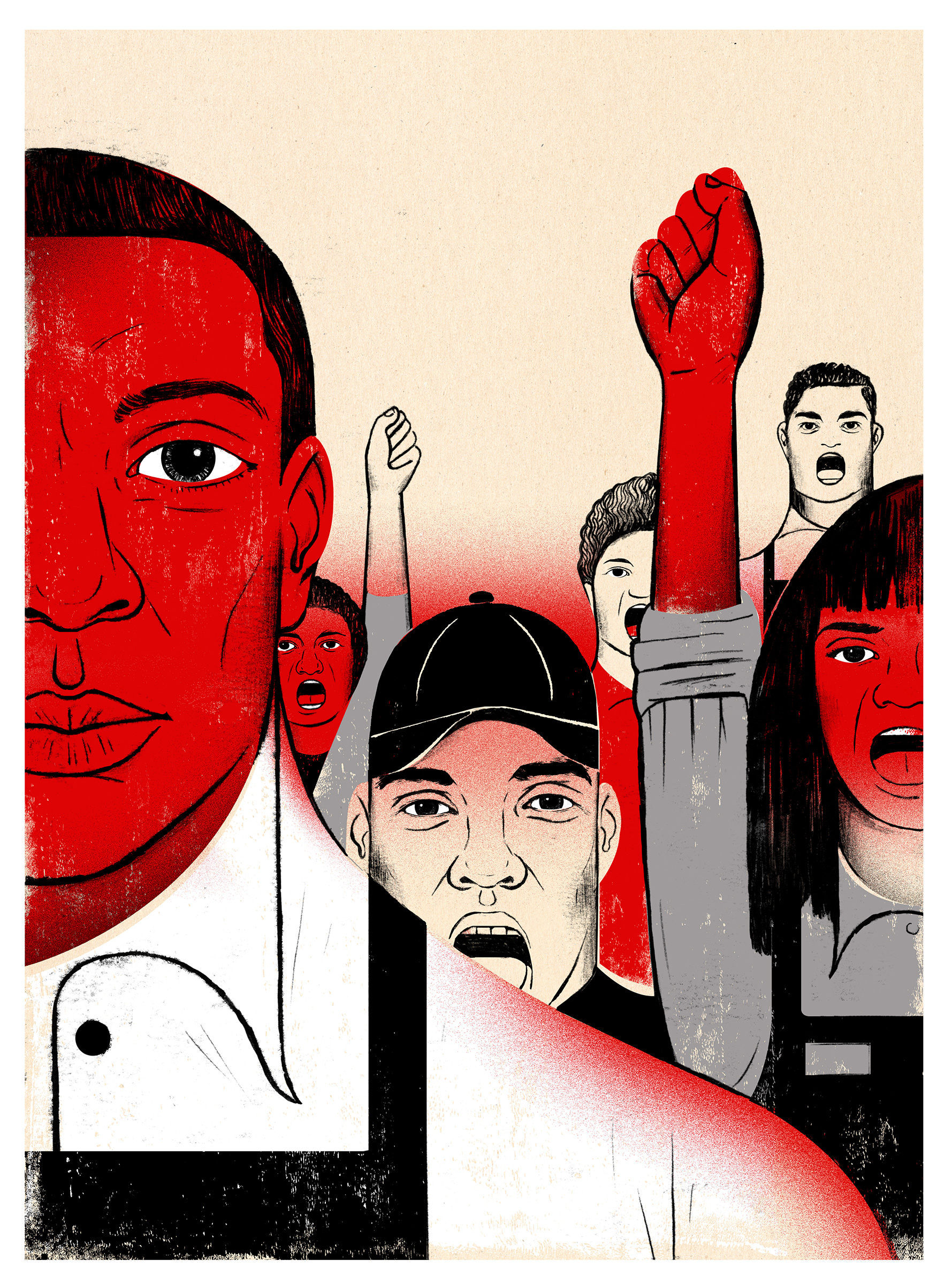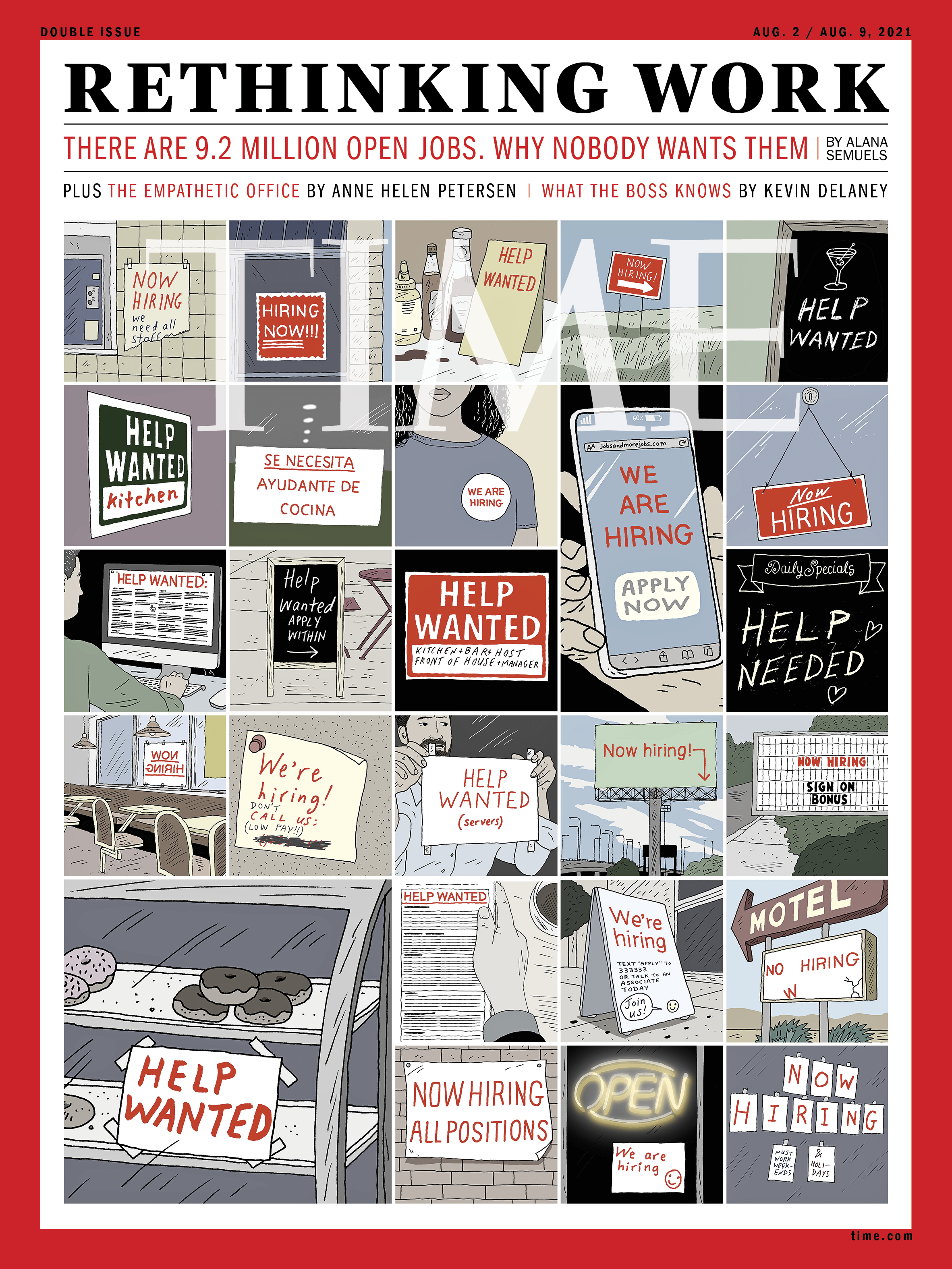
Xue Vang had long known that his job deicing planes, loading bags and chocking wheels at the Missoula airport was dangerous, especially in the Montana winter, when blinding snow and rain obscure the spinning engines that can suck in a human body.
But this past winter, the conditions at Unifi, which services planes for United and Delta, became intolerable. Because of the pandemic, understaffing was so bad that Vang was simultaneously handling two or three planes on the “ramp,” or tarmac, while making sure new trainees didn’t get inhaled into the engines.
One day, Vang’s colleague Jared Bonney was complaining that he’d been promised a raise for years that never materialized. “I was like, ‘Join the club,’” Vang recalls. Bonney’s pay was capped at $10.40 an hour; Vang, whose job was more senior, was capped at $11.50. Single adults would need to make $14.13 an hour to support themselves in Missoula, according to MIT’s living-wage calculator.
Other Unifi workers started sharing complaints about low pay, lousy conditions and broken promises of raises, even though their jobs required specialized training and were critical to flight safety. A walkout could get them fired—Unifi was not unionized—and plans for one three years earlier had fizzled. But in April, when Bonney says a Unifi HR manager called the workers “unskilled” and undeserving of more money, getting fired didn’t seem so bad. Not when Panda Express and Taco Bell were posting job openings starting around $14 an hour.
“It was just a boiling point for me,” says Bonney, 25, who couldn’t save money after paying his bills— even while living with his parents.

The strike happened on a cold Monday in April. Six of the 15 workers who had vowed to participate, including Bonney and Vang, showed up for their 4 a.m. shift and clocked in with the intention of telling their supervisor they were staging a walkout. They were met by the regional manager, who had been alerted to their plans by one of their colleagues. Rather than grounding flights, the workers had their badges confiscated.
Undeterred, they regrouped in the baggage area, then went to Target to get supplies to make picket signs. For the rest of the week, they and two other workers who had missed the initial walkout picketed outside the airport. Within two weeks, all had been fired.
Vang has no regrets. “I hope that we spark something,” he says. “We want this movement to keep going—people deserve a living wage.” Unifi did not return multiple emails and calls seeking comment.
Read More: Companies Are Embracing Empathy to Keep Employees Happy. It’s Not That Easy
The pandemic was a breaking point for low-wage workers like Bonney and Vang, who are fed up with being treated poorly while barely making enough to get by. Over the past 40 years, while wages have soared for higher-income workers, they’ve barely budged for people at the bottom of the income scale. From 1979 to 2019, wages for the lowest-paid decile of workers rose 3.3% when adjusted for inflation, while wages for the top 5% of workers rose 63.2%, according to the Economic Policy Institute, a left-leaning think tank. Over that time, as middle-class jobs were automated or sent overseas, and as more people vied for what was left in the wake of the 2001 and 2007–2009 recessions, employers had the upper hand. By one estimate, 53 million people—around 44% of U.S. workers— were low-wage before the pandemic, making an average of $10.22 an hour.
But after 17 months of having to show up to jobs in person, putting their lives on the line while white collar and knowledge workers stayed home and saw their savings grow, America’s hourly workers may be gaining leverage. Entire shifts of employees at fast-food restaurants, amusement parks and airports are walking off their jobs, pasting handwritten notes on the doors that say we quit. In Worcester, Mass., more than 700 nurses have been on strike since March 8, protesting working conditions and reduced staffing as their parent company, Tenet Healthcare, posted a large profit during the pandemic. Frito-Lay workers in Kansas went on strike July 5 to protest low wages and 84-hour workweeks, and Volvo employees in Virginia went on strike in April and again in July, calling for wage increases and signing bonuses. Farmworkers in California are walking off the job to demand higher pay.

Employers are being forced to raise wages and offer perks like college tuition and signing bonuses. What economists call the reservation wage for people without a college degree—the lowest pay people are willing to accept to take a job—rose 26% in March compared with the same time last year.
It’s too soon to tell if this is just a characteristic of an economy suddenly reopening and leaving employers scrambling for workers, or whether these changes will be permanent. There were signs, however, that workers were losing patience with years of low pay even before the pandemic. The rock-bottom unemployment rate—in November 2019 it hit 3.5%, the lowest in decades—gave them confidence to start pushing back.
Read more: Will Animal-Friendly Workplaces Catch on as Workers Demand Flexibility to Care for Pets?
In 2019, there were more work stoppages involving 1,000 or more employees than in any other year since 2001. The federal minimum wage is just $7.25 an hour, and 20 states have not increased their minimum wage beyond that. All other states have either tied the minimum wage to inflation, which ensures it will keep rising as prices do, or increased it.
Companies like Amazon and Costco announced as early as 2018 that they were increasing pay for all U.S. employees to $15 and $14, respectively, a move that forced competitors to pay more too. (In March, Costco raised its starting wage to $16 an hour.)
“The workforce was getting restless after years of stagnant wages and a decline in union representation that traditionally gave them a voice,” says Thomas Kochan, a professor of work and employment research at MIT’s Sloan School of Management. “For low-wage workers, the pandemic demonstrated how much inequality there is—it’s really leading them to ask, Is this the kind of job I want? Or should I leave?”
A century ago, widespread labor unrest led to an overhaul in the way workers were treated in America. At the turn of the 20th century, the U.S. had low unionization rates and few social benefits compared with other industrialized nations. But as labor shortages grew during World War I and inflation rose at the end of the war, workers began to revolt. In 1919, one-fifth of the nation’s workforce participated in strikes, including the walkout of 350,000 steel workers.
Determined to head off unionization and maintain some control of workers’ lives, companies started to offer more benefits, figuring they could reduce turnover and increase productivity, says Joseph A. McCartin, a professor of history at Georgetown University. “Employers were realizing it simply doesn’t pay to treat workers like machinery that you are going to use up and throw out—when you do that, they organize,” McCartin says.
This ushered in an era of “welfare capitalism” in which companies offered benefits like pensions, apprenticeship programs, stock ownership and health insurance. U.S. Steel, which had refused to shorten the 12-hour workday during the 1919 strike, reduced it to eight hours in 1923. General Electric offered a pension plan and paid vacation for blue collar workers; General Motors helped employees buy homes and set aside a portion of its profits for employee bonuses.
Accidents decreased, productivity went up, and turnover slowed; General Electric’s turnover rate of 50% in the 1910s fell to half that by 1922.

Get a print of TIME’s “Rethinking Work” cover here
What happened a century ago might sound familiar. Some of today’s biggest companies are announcing big pay and benefit increases to attract workers and reduce turnover. Since the pandemic began, Target has said it would permanently raise the starting wage for U.S. employees to $15 an hour, a move that Best Buy followed. Beef producer JBS USA said in March it would start paying two-year-college tuition for its 66,000 workers and their dependent children. In April, national garbage collection and recycling company Waste Management said it would offer 36,000 full-time workers and their dependents free tuition for undergraduate and graduate degrees in a partnership with Guild Education, which teams up with companies to offer educational benefits to employees.
This is a reversal from what most employers have been doing over the past few decades—cutting back benefits and pushing more financial responsibilities onto workers. But as America ages, many companies are realizing that a big share of their employees are going to retire soon and that they might not be able to find enough people to replace them. The retirement rate of baby boomers shot up during the pandemic.
“It became apparent that we needed to do something fundamentally different and radical to attract and retain talent,” Tamla Oates-Forney, the chief people officer at Waste Management, told me. Even before the pandemic, demographic shifts were making it difficult for Waste Management to find the drivers and technicians they needed; millennials and Gen Z workers were going into other industries, she says. Waste Management hopes that offering free education will attract people who may want to start out driving a truck and then work their way up in the company. It also added more money for backup childcare for workers during the pandemic.
Employees who don’t feel their company offers advancement opportunities will leave for one that does. Sara Stark, 20, started working at a Chipotle just north of Atlanta when she turned 16. As she kept working there for two and then three years, she got just one raise, worth 15¢, to add to her $10-an-hour starting wage. “I spent three years of my life there and nothing changed,” she says. When Chipotle lost workers during the pandemic and Stark was pushed harder and harder, cleaning and sanitizing the restaurant with bleach by herself, she got fed up and quit in October. She soon found a job at Starbucks, which offered a college-scholarship program, free mental-health benefits and opportunities for promotion. After just a few months, Stark was promoted to a managerial role, making $12.70. She plans to use Starbucks’ online education program next year to go back to school and study design. “The list of benefits Starbucks offered took up our whole training session,” she says. (In a statement to TIME, Chipotle says it offers benefits like tuition reimbursement, mental-health care, and a bonus program. As of May, it pays $15 an hour.)

Once they raise wages and offer benefits like higher tuition, it will be difficult for companies to reverse them. Professional workers may be quitting their jobs en masse to go live their dreams, but the pandemic has also made low-wage workers take a step back and think about what they’re doing with their work lives, says Rachel Carlson, the CEO of Guild Education.
“The plurality of workers are saying, ‘O.K., $15 an hour, but what do I do all day? And is there a job after that for me, and where does it take me?’” she says. “Career mobility is now the value proposition that matters for companies.”
Workers’ increased leverage is already playing out in the job market. Wages have risen for three straight months, according to the most recent jobs report. They’re a full 10% higher in the leisure and hospitality sector than they were two years ago—764,000 workers in that industry quit in May alone.
Some workers who walked away from bad jobs saw big pay bumps in their new positions. A month after Jared Bonney got fired from the Missoula airport, he went to a local casino to apply for a job. He was hired on the spot and promoted to assistant manager after a few months. His base wage is still low—$12 an hour—but he can make a lot of money in tips, he told me. On a good night, he’ll make $23 an hour.
Sandra Sibert, 48, was one of the 3,400 workers at a Smithfield meat plant in South Dakota who rejected the company’s initial contract offer in June, saying they deserved a raise as food and gas prices increased. Workers have been quitting en masse, she says—as many as 50 a week, up from one or two a week before the pandemic. After workers rejected the initial contract, which would have altered break time and kept pay the same, the company offered a $1.75 raise, kept breaks the way workers wanted and included a $520 bonus for them. Workers accepted. The course of negotiations “was not unusual,” Keira Lombardo, Smithfield’s chief administrative officer, said in a statement.
If Sibert and Bonney are making more than they did before the pandemic, they’re still far from middle class. Many workers who participated in walkouts or strikes over the past year, or who switched jobs for higher wages, still may be struggling. They’re squeezed by the highest apartment-rental costs in more than two years and prices for consumer goods that climbed 5.4% from a year ago, the biggest annual increase since 2008.

Even with a raise, berry pickers in California who walked out will be making around $30,000 a year—if they work full time. Companies like Disney are offering $1,000 hiring bonuses—but housekeepers will still be making just $16 an hour if they take the jobs.
That’s the result of four decades of declining union power and a stagnant minimum wage. “The idea that any short-run shortages that do exist would undo 40 years of employers’ ability to suppress wages—it just does not ring true whatsoever,” says Heidi Shierholz, a former Obama Administration economist who works at the Economic Policy Institute. The labor movement saw further setbacks this year when an effort to organize an Amazon warehouse in Alabama failed and the U.S. Supreme Court struck down a California regulation that let union organizers meet with farmworkers on farm property.
Progressive groups say that the PRO Act, which passed the House in March and would make it easier for workers to organize, is what’s needed to help employees gain more power in the long term. Conservatives say people will be returning to jobs once all states end more generous additional unemployment benefits offered during the pandemic.
Meanwhile, workers are seeking out the companies—and industries—that are giving raises alongside a path to better careers. Those companies aren’t having trouble filling positions. After it announced its educational benefit, Waste Management’s May recruiting drive attracted 1,200 people; the company made 420 offers, and 70% of those people have started working for the company. More than half of applicants mentioned the free college-tuition offer.
As Xue Vang is finding out, it can be hard to find work at companies that have decided to treat workers well. After Unifi fired him, it raised wages to keep the remaining workers on—but only to $11 an hour. Vang started applying for other jobs and got a few offers, but he hasn’t accepted one yet.
He wants to hold out for something better—he has his sights set on a full-time job with an airline, rather than at an airline contractor. A few of his former Unifi co-workers have gotten jobs at Alaska, where wages are higher, but Vang says the airline told him his timing was bad—it had just hired a flood of employees who had left jobs to work somewhere that paid more than the minimum wage.
More Must-Reads from TIME
- Why Trump’s Message Worked on Latino Men
- What Trump’s Win Could Mean for Housing
- The 100 Must-Read Books of 2024
- Sleep Doctors Share the 1 Tip That’s Changed Their Lives
- Column: Let’s Bring Back Romance
- What It’s Like to Have Long COVID As a Kid
- FX’s Say Nothing Is the Must-Watch Political Thriller of 2024
- Merle Bombardieri Is Helping People Make the Baby Decision
Contact us at letters@time.com